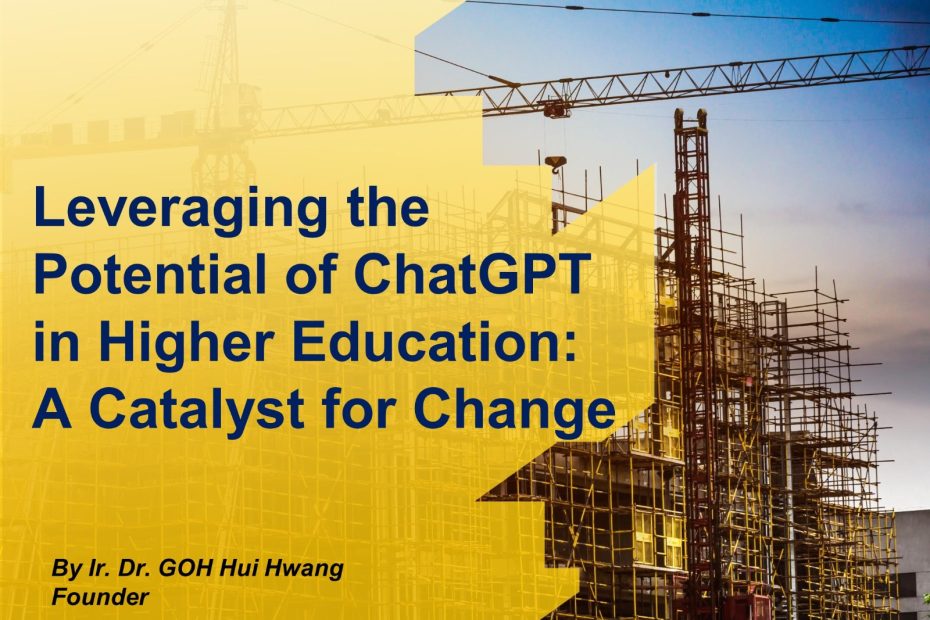Author: Ir. Dr. GOH Hui Hwang | 18 April, 2023
Many industries and sectors are being transformed by Artificial Intelligence (AI), and higher education is no exception. One of the most notable applications of artificial intelligence in higher education is the usage of chatbots. Chatbots are computer programmes that use AI and natural language processing to replicate human dialogue. The purpose of these chatbots is to answer questions, provide guidance, and aid students and instructors.
ChatGPT, an AI-powered chatbot that employs OpenAI’s GPT-3.5 architecture, is currently one of the most promising chatbots available. ChatGPT is meant to comprehend and answer to intricate queries, making it an ideal instrument for higher education. In the following ways, ChatGPT can serve as a catalyst for change in higher education:
Increasing Student Achievement
ChatGPT can facilitate student learning by giving individualised support and direction. ChatGPT enables students to receive immediate responses to their questions, hence enhancing the efficiency and effectiveness of the learning process. Additionally, ChatGPT can give students with extra resources, such as movies, articles, and other learning tools, to aid in their comprehension of difficult topics. This may result in improved academic achievement and a greater comprehension of the subject matter.
Enhancing Faculty Productivity
ChatGPT can also be utilised to increase instructor productivity. Faculty members can automate typical duties such as responding to frequently requested inquiries, grading assignments, and providing feedback using ChatGPT. This can free up their time so they can concentrate on other vital responsibilities, such as research and instruction. ChatGPT can also provide faculty members with information into student performance and engagement, enabling them to better adjust their teaching approach to their students’ requirements.
Improve Accessibility
ChatGPT’s ability to improve accessibility for students with impairments is one of its most significant advantages. ChatGPT can allow students with visual and hearing impairments access to information and resources that would otherwise be difficult to obtain. ChatGPT can also be utilised to give translations for students who do not speak the language of instruction, so making education more inclusive and accessible.
Difficulties and Restrictions
While ChatGPT has the potential to revolutionise higher education, its implementation is not without obstacles and restrictions. One of the most significant obstacles is the requirement for training and growth. Teachers and students must be instructed on how to properly use and integrate ChatGPT into their teaching and learning activities. Another obstacle is the requirement for data privacy and security. ChatGPT must be developed to safeguard the privacy and security of student and teacher information.
Another shortcoming of ChatGPT is its linguistic dependence. While ChatGPT can comprehend and react to complicated inquiries, it may be unable to comprehend cultural contexts or subtleties. This can result in misconceptions or incorrect interpretations, which can hinder the learning process.
Social Responsibilities
In its current form as an artificial intelligence language model, ChatGPT has no visible effect on social justice or academic attainment. However, the method of production and application can change the spheres.
If AI language models such as ChatGPT are trained on biased data or are not adequately supervised for fairness, they can perpetuate biases and inequalities. A model of artificial intelligence may acquire biases and prejudices from its training data, such as racist, sexist, or discriminatory phrases. It is therefore essential to develop AI models with accountability, transparency, and fairness in mind.
The usage of ChatGPT and related language models based on artificial intelligence has both positive and negative consequences on colleges. These models can be utilised to simplify the completion of research papers, essays, and other academic tasks. ChatGPT offers a variety of advantages to the academic and research sectors.
Issues regarding academic integrity and the role of AI in education are raised as the use of AI language models in higher education gains widespread. Some teachers and scholars have questioned the use of artificial intelligence (AI) models in academic writing, arguing that this tendency inhibits critical thinking and originality. Others have expressed concern that AI models could be abused to manufacture academic work, aid in exam cheating, or otherwise mislead student performance evaluations.
Conclusion
ChatGPT possesses the potential to revolutionise higher education. It can improve student learning, staff productivity, and accessibility for students with impairments. There are, however, obstacles and constraints that must be overcome to ensure its effective application in higher education. Academic members and students must be instructed in the proper usage of ChatGPT, and data privacy and security must be a major focus. Notwithstanding these obstacles, ChatGPT’s potential benefits are substantial, and its application in higher education can serve as a catalyst for change. Despite the fact that ChatGPT has no inherent bearing on social justice or higher education, its implementation and development may have such effects. It is essential to prioritise fairness, openness, and accountability in the development and application of AI language models such as ChatGPT.
Ir. Dr. GOH Hui Hwang
Founder
IPM Group

